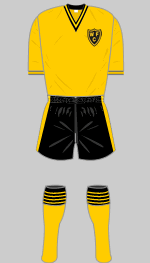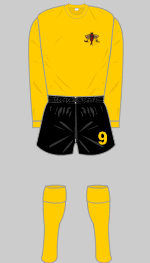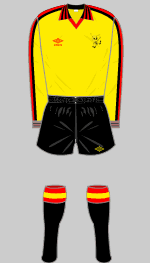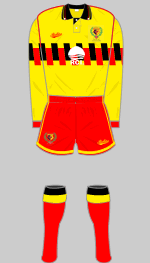Kit History
Watford Rovers
1881

1888-1889 h r

1889-1890 h r
West Herts
1890
Formed by merger of Watford Rovers and West Hertfordshire Rangers

1890-1893 s

1893-1897 h q r s
Watford
1898
Formed by merger of West Herts and Watford St Mary's

1898 q r s

1903-1909 h q s

1909-1910 s

1910-1914 h s

1914-1919 h

1919-1920 s

1921-1922 w

1922-1923 s

1927-1928 h

1928-1938 g p s

1938-1939 b

1947-1948 w

1949-1951 t w

1954-1957 p w

1957-1959 p

1960-1961 p v

1962-1963 v

1962-1963 v

1963-1964 v

1964-1965 a v
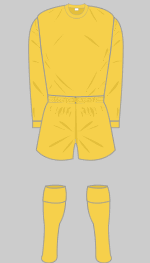
August 1965 v

Sept 1965-1968 v

Nov 1971-1972 o

1973-1974 v

1974-1976 e j n u v

1978-1979 v

1979-1982 c e j
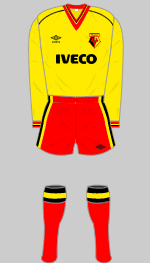
1982-1983 c k l

1983-1985 c e k l v

1985-1988 c e k l

1988-1989 k m

1989-1991 c i k m

1993-1995 c k l
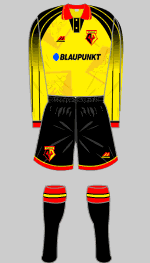
1995-1996 c k l

1996-1997 c k l

1997-1998 c k l

1998-1999 c k

1999-2001 c k l

2001-2002 c

2002-2003 c

2003-2005 c k

2005-2006 f k

2006-2007 f k

2008-2009 f

2009-2010 f

2010-2011 f

2011-2012 f
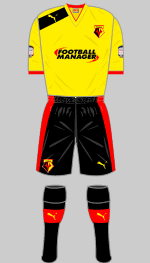
2012-2013 f

2013-2014 f

2014-2015 f
Background
 The club takes the year of its formation as 1881 when Watford
Rovers was formed. This club amalgamated in 1890 with West Hertfordshire
Rangers, believed to have been formed in 1865 and became known as West Herts. In 1896, the club joined
the Southern League Second Division, turning professional the following
year. For a period the town boasted two professional clubs but it quickly
became clear that this was not sustainable and in 1898, West Herts
and Watford St Mary’s FC merged to form Watford FC. The first mention
of the club's colours dates from 1888, when they wore blue shirts. Over
the next few seasons, press reports researched by Trefor Jones, describe
their shirts as "olive and scarlet" and later "orange and
yellow" or "amber and scarlet." These were combined in attractive yellow, red and green vertical stripes when the team kicked off as Watford FC in 1898 (see illustration). Around the turn of the century, the stripes changed to hoops.
The club takes the year of its formation as 1881 when Watford
Rovers was formed. This club amalgamated in 1890 with West Hertfordshire
Rangers, believed to have been formed in 1865 and became known as West Herts. In 1896, the club joined
the Southern League Second Division, turning professional the following
year. For a period the town boasted two professional clubs but it quickly
became clear that this was not sustainable and in 1898, West Herts
and Watford St Mary’s FC merged to form Watford FC. The first mention
of the club's colours dates from 1888, when they wore blue shirts. Over
the next few seasons, press reports researched by Trefor Jones, describe
their shirts as "olive and scarlet" and later "orange and
yellow" or "amber and scarlet." These were combined in attractive yellow, red and green vertical stripes when the team kicked off as Watford FC in 1898 (see illustration). Around the turn of the century, the stripes changed to hoops.
In 1900 Watford won the Southern League Second Division title and in 1915 they won the Southern League championship itself. The hoops had been dropped in 1909 in favour of far more prosaic white shirts and black knickers and in 1914 black and white striped shirts were adopted.
Along with the rest of the Southern league First Division, Watford became
founder members of the new Third Division of the Football League in 1920. They made little
impression and in 1927, facing serious financial  difficulties, a new start was attempted: the club announced that the unpopular "semi-mourning" black and white strip was dropped in favour of blue and white.
Their old nickname of "The Brewers," which had never really caught on, was dropped and the team became "The Blues."
difficulties, a new start was attempted: the club announced that the unpopular "semi-mourning" black and white strip was dropped in favour of blue and white.
Their old nickname of "The Brewers," which had never really caught on, was dropped and the team became "The Blues."
The first evidence of a crest comes from 1927 when a simple shield with lettering appeared on Watford's plain white change shirts: it does not seem to have been worn on the first choice blue tops.
In the early 1930s Watford's colours were registered as turquoise and white, a unique combination. As all records of the period have been destroyed, this has yet to be corroborated. Graham Brack recalls reading an account by a former player who made his debut in 1936 and who mentioned that this unique colour was adopted in an attempt to avoid the expense of having to buy a set of change shirts. Eye witness accounts confirm that the team certainly played in conventional blue in post-war years even though many publications continued to describe their colours as turquoise and white.
 In the seasons preceding the Second World War Watford's performances
improved markedly and they finished in fourth place for four consecutive
seasons.
In the seasons preceding the Second World War Watford's performances
improved markedly and they finished in fourth place for four consecutive
seasons.
After the war, Watford continued to struggle and had to apply
for re-election in 1951. The club crest of the period (which did not appear on team shirts) included a hart (male  deer), the symbol of Hertfordshire. This motif would be revived much later on.
deer), the symbol of Hertfordshire. This motif would be revived much later on.
In 1959 Watford adopted gold and black along with a revival of the old crest from 1927: the effect was more or less immediate. In 1960 they won promotion to the Third Division where they stayed for nine seasons before winning promotion to Division Two for the first time in 1969. A year later they reached the FA Cup semi-final where they were defeated by Chelsea.
 The "WFC" badge was dropped in 1962 and for much of the decade the team played in plain gold shirts with no adornments apart from black trim, very much the fashion of the period. In 1968, however, in keeping with the new nickname adopted
The "WFC" badge was dropped in 1962 and for much of the decade the team played in plain gold shirts with no adornments apart from black trim, very much the fashion of the period. In 1968, however, in keeping with the new nickname adopted 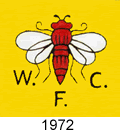 by their supporters' club, a red hornet was embroidered onto the shirts. This seems to have been dropped midway through the 1971-72 season but appeared again, with slightly different lettering, the season after.
by their supporters' club, a red hornet was embroidered onto the shirts. This seems to have been dropped midway through the 1971-72 season but appeared again, with slightly different lettering, the season after.
A cartoon version  known as "Harry the Hornet" was adopted in 1974 but fripperies like this are rarely popular with hard-core supporters and Harry did not last long. Relegations in 1972 and 1975 took Watford back to Division Four.
known as "Harry the Hornet" was adopted in 1974 but fripperies like this are rarely popular with hard-core supporters and Harry did not last long. Relegations in 1972 and 1975 took Watford back to Division Four.
 In 1976
Watford made yet another change in their colours, this time to yellow,
red and black. A new crest was introduced in 1978 that featured a hart (although it is frequently but incorrectly identified as the head of a moose). This striking image would serve the club for well over 30 years although there have been subtle design changes along the way.
In 1976
Watford made yet another change in their colours, this time to yellow,
red and black. A new crest was introduced in 1978 that featured a hart (although it is frequently but incorrectly identified as the head of a moose). This striking image would serve the club for well over 30 years although there have been subtle design changes along the way.
 The arrival of pop star Elton John
as chairman in 1977 marked the beginning of a remarkable climb to the
top. Graham Taylor was appointed manager and in 1978, “The Hornets”
stormed to the Fourth Division title. The following season they reached
the semi-finals of the League Cup and won promotion to Division Two.
The arrival of pop star Elton John
as chairman in 1977 marked the beginning of a remarkable climb to the
top. Graham Taylor was appointed manager and in 1978, “The Hornets”
stormed to the Fourth Division title. The following season they reached
the semi-finals of the League Cup and won promotion to Division Two.
 In 1982 Watford’s dream was realised with promotion to Division
One. Against all expectation, they finished in second place behind Liverpool
the following season to secure a place in the UEFA Cup. In 1984 they reached
the FA Cup final where they lost 0-2 to Everton.
In 1982 Watford’s dream was realised with promotion to Division
One. Against all expectation, they finished in second place behind Liverpool
the following season to secure a place in the UEFA Cup. In 1984 they reached
the FA Cup final where they lost 0-2 to Everton.
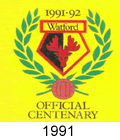 In 1987 Taylor resigned and was replaced by Dave Bassett. Watford were
relegated in 1988 and, having narrowly missed promotion in their first
season, the club struggled. In 1996, Graham Taylor returned as general
manager but he could not prevent relegation to Nationwide
Division Two (formerly the Third Division).
In 1987 Taylor resigned and was replaced by Dave Bassett. Watford were
relegated in 1988 and, having narrowly missed promotion in their first
season, the club struggled. In 1996, Graham Taylor returned as general
manager but he could not prevent relegation to Nationwide
Division Two (formerly the Third Division).
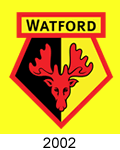 In 1998 they won the championship and a year later, they beat Bolton
Wanderers in the play-off final to earn a place in the Premier League. This
time they could not hold on to their status and were relegated the following
season, seven points adrift at the foot of the table.
In 1998 they won the championship and a year later, they beat Bolton
Wanderers in the play-off final to earn a place in the Premier League. This
time they could not hold on to their status and were relegated the following
season, seven points adrift at the foot of the table.
Watford made semi final appearances in the FA Cup (2003) and League Cup
(2005) while  in the second flight before they unexpectedly beat
Leeds United in the play-off final to make another brief return to the Premiership.
To mark the occasion, which coincided with their 125th anniversary, the
club adopted a kit featuring red shorts not unlike the one worn in the
First Division during the 1980s and a suitably modified crest.
in the second flight before they unexpectedly beat
Leeds United in the play-off final to make another brief return to the Premiership.
To mark the occasion, which coincided with their 125th anniversary, the
club adopted a kit featuring red shorts not unlike the one worn in the
First Division during the 1980s and a suitably modified crest.
In June 2012 ownership was transferred from Laurence Bassini to the Pozzo family who had previously owned the Italian club, Udinese and three seasons later they won promotion back to the Premier League having finished as runners-up in the Championship.
Sources
* Yellow V neck shirts occasionally worn in 1977-78.
- (a) Club Colours (Bob Bickerton 1998)
- (b) Swindon Town FC - Images of Sport (Richard Mattick 2000)
- (c) empics
- (d) Football Focus
- (e) Classic Kits
- (f) Watford Official Website
- (g) The Football Encyclopaedia (Associated Sporting Press 1934)- information provided by Arthur Fergus
- (h) Trefor Jones - the club's official historian
- (i) Greg Hattingh
- (j) Pete's Picture Palace
- (k) True Colours 2 (John Devlin 2006)
- (l) David King
- (m) Pat Heywood
- (n) Steve Atkinson
- (o) Alick Milne
- (p) Hornet History - independent site run by Wayne Godfrey that concentrates on the post-war era.
- (q) Watford Junction
- (r) Wayne Godfrey
- (s) Sarah Priestley, Heritage Officer, Watford Museum
- (t) Simon Monks
- (u) Christopher Worrall
- (v) Geoff Allen
- (w) Keith Ellis (HFK Research Associate)
Crests are the property of Watford FC. Crest artwork provided by Geoff Allen.



